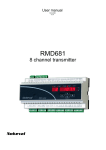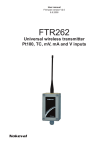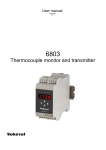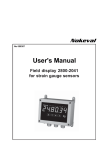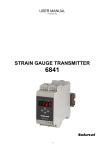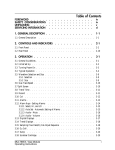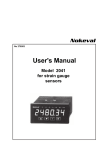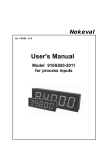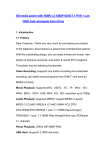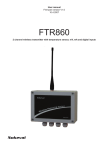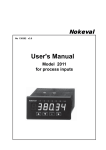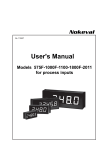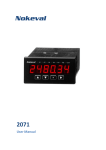Download 2022Setp - Nokeval
Transcript
USER MANUAL 5.8.2008 V1.3 Setpoint unit 2022Setp 1 INTRODUCTION 2022Setp is a special edition of Nokeval 2022 multi-input indicator. It is available in wall-mounted “2800” enclosure or in a 1/8 DIN panel enclosure. Normally it is equipped with an analog output card, and possibly with serial communications card, an alarm relay card, or another analog output card. There is always one mA/V process input with transmitter supply 24 V 250 mA. Configuration can be fully performed either with the front panel buttons or using serial communications and Mekuwin PC software. The latter option however requires a serial communications card. SPECIFICATIONS Input card Serial communications card Galvanic isolation Update rate Yes 6 / sec typ mA input Input resistance Physical range Calibr accuracy Linearity Tempco Transmitter supply 50 ohms 0..24 mA ± 8 µA ± 3 µA ± 100 ppm/°C 24 V ±20% 260 mA V input Input resistance Physical range Calibr accuracy Linearity Tempco 1.1 Mohms 0..12 V ± 5 mV ± 2 mV ± 100 ppm/°C Ports Galvanic isolation Protocol Baud rates Response Alarm relays Configuration Ratings Analog output card General Galvanic isolation Power supply Yes (shared with serial communication and another output card) mA output Max range Calibr accuracy Linearity Max load 0..20.8 mA typ ± 8 uA ± 4 uA 12 V (600 ohm) V output Max range Calibr accuracy Max load 0..10.5 V typ ± 5 mV 3 kohm RS-232 or RS-485 Yes (shared with analog outputs) Nokeval SCL 300..19200 bit/s 200 ms max One or two two-relay cards (2000REL2) or one three-relay card (2000REL3) 250 VAC 2 A non-inductive load 85-260 VAC or 12-32 VDC Ordering The full ordering code for a panel indicator with one analog output and 85-260V supply is: 2022SETP-OUT-230VAC To add a serial card, include -RS- in the chain. To have relay cards, include -REL2- or -REL3-. Only two option cards can be included! And for a wall-mounted indicator precede with 2800-: 2800-2022SETP-… 2 INSTALLATION Connectors 6 5 4 Com 3 3 TxD 2 2 Com 1 1 RxD +V V 6 A Com 5 B mA 4 REL3 REL2 RS-485 SERIAL OUT +24V 2W +mA ! 6 RS-232 2022Setp 6 5 4 3 2 1 3 5 1 1 5 4 4 2 6 2 3 2 1 1 Power supply 2 +L 3 -N 7 8 9 connectors 3 and 4 must always be linked together! Slot A = 2022Setp input card Slot B = Analog output (or other option card) Slot C = The second option card If a pre-fuse is used in 230V power supply connection, it should be at least T500mA. The indicator has an internal pre-fuse. The polarity of the power supply has no matter. An active milliamp signal is connected to A5+ and A3-. A two-wire transmitter may be connected to A6+ and A5-. Voltage signal is brought to terminals A1+ and A3-. Note that slot A Jumpers on off 2000-RS Term Fs RS232 RS485 RS485 (Factory setting) Last unit on bus on on on off off off Term Fs Term Fs Term Fs Configuration match those in MekuWin. The settings are described in chapter Settings / Serial communications, and the MekuWin program has a manual of its own. Using front panel The indicator can be fully configured using the front panel keys. The configuration settings are explained in chapter Settings, and using the front panel is described in chapter User interface. The Slot parameter in Mekuwin is used to select which “slot” or card is configured. 0=Master (setpoint), 1=slot A (input), 2=slot B (output), 3=slot C. The indicator keeps measuring and updating the alarms, but the serial output is not available. The indicator keeps measuring during the configuration, and the MekuWin monitor function can be used to see the current readings. Using configuration software MekuWin program (free from Nokeval web site) is used to configure the device using RS-232 or RS485 communication. If connection fails, check the communications settings using front panel keys to 3 OPERATION Data flow Internal bus Display 135000 Blink Serial Setpoint Ch 8 Ana output Scaling Input Ch 1 Alarms The mA or V input is first measured. This information is converted to a scaled reading (in any engineering units) using two freely selectable sample points, e.g. 4.112 mA corresponds to 0 bar and 16.501 mA corresponds to 6 bar. This is set up in slot A configuration menu. The reading is put available on internal channel 1, to be available for the outputs and the display. There is one user-adjustable setpoint, that can be changed using the front panel buttons ^ and v. This setpoint is available on channel 8. The alarms and analog output(s) can be taken from channel 1 (input) or channel 8 (setpoint). 4 USER INTERFACE Front panel Normal state In normal state, this device displays the current measurement reading continuously functioning as an indicator. • The display can be set to three different modes. They are: • Normal. The display consists of a channel number and a reading. The channel can be selected with ^v keys. Channels: 1=input, 8=setpoint. • Setpoint. The display is always showing the adjustable setpoint (channel 8), and it can be adjusted using buttons ^ and v. MeaSet. The display shows normally the input (channel 1), but can be requested to show the setpoint by pressing ^ or v for the time specified in the settings. The setpoint can then be adjusted. The display is returned to input display when no buttons is pressed for a while. The indicator LEDs A1-A4 show the status of the alarms. The Conf LED is lit when in configuration state. Additionally, M1 blinks when the setpoint is being adjusted. Configuration state Press * and ^ simultaneously two seconds to enter configuration state. First, select the slot to be configurated. The options are Master, Slot A, Slot B, and Slot C. Proceed with >. If configuration password is set, you will now need to enter it (Cod.0 displayed). In case the password is not known, switch the power off, hold * and > keys pressed and switch the power on again. 5 *+^ Slot Master Conf > Submenu1 Slot A * Slot B Slot C Submenu2 ^ v Submenu3 ... > > > > * ^ v Submenu1 Item1 > * ^v> Editing ... ... ... ... * * ... Save Undo To set a password, push ^ to select Set (means password will be used), then push > to enter the new password. Cod.0 is shown. The password is a sequence of six keypresses using all the four keys. Enter the same password twice; if they match, Set is shown again and you can exit with *. If they didn’t match, Off is shown. Redo from start. To disable a password, push v to select Off and exit with *. The main level of the configuration menu is shown. You can select among menu items using ^v keys. To edit the setting, push > to start editing, and * to get back to the menu. How to edit, see chapter Editing. Most data types are edited simply with ^v keys, finally exiting with * key. Floating point values, such as scaling and lopass filter, are edited with ^v> keys: select digit to edit (blinks) with > and change it with ^v. When the decimal point is blinking, it can be moved with ^v. The first digit can be replaced with a minus sign. When all settings are done, exit from the menu with * key. Two options are shown: Save to keep the settings made, and Undo, to discard all the changes. Select Save or Undo and push *. Finally, exit from the slot selection by third * (or select another slot with ^v and so on). Monitor state and simulation Monitor function can be used while troubleshooting to view some internal values of the indicator. It can be accessed either from the front panel or using the configuration software. update them. Then they may be changed by the user to test the system. How to lock in Mekuwin, see its manual. To lock using the front panel, do as follows: 1. Enter the monitoring state as described and the slot you want to. 2. Select the item to be locked using ^v buttons. Do not push > yet. 3. Press and hold > button. Then push ^ also. Release them both. 4. Now you can enter a new value to simulate/test something. 5. Exit with *. To return to normal operation, do the same, but while holding >, push v. Monitor mode is entered in the normal state by pressing * and v together. Select slot with ^v and push > to enter. The monitored item can be selected with ^v. To return to slot selection, push *. To return to normal state, push * once more. Objects to monitor are described in sections of each card. Some monitor items have a possibility to be locked, so that the indicator does not anymore 6 MASTER / SETPOINT The master is responsible of the user interface (display and buttons) and of the setpoint. To set up an analog output following the setpoint, see chapter Analog output. Configuration menu • Conf Gen Gen Bright Setpoint CfCode • • Setpoint Mode Normal: Displaying channel number + reading. Setpoint: Displaying the setpoint all the time. MeaSet: Displaying the input reading or the setpoint. Setpoint\Startup Setpoint value source after power-up. • Preset: The initial setpoint value is set in the next menu item. • Last: The setpoint is preserved during power-off. Startup Preset Min Max Dec Delay Setpoint\Preset Setpoint value after power-up. This item is hidden if Startup is set to Last. The configuration menu of the master is divided in two sections, Gen (general) and Setpoint settings. Setpoint\Min, Setpoint\Max These define the range where the setpoint can be adjusted. Gen\Bright Display brightness 1-15. Default value 7. Gen\CfCode Password for all the configuration settings. Will apply for the other cards too. If the password is set and forgotten, turn the power off, hold * and > pressed and switch power on. To set the password, select Set, push >, and enter the same password twice. If Set is displayed again, you can exit with *. The password consists of six keypresses using all the buttons. Setpoint\Dec Number of digits after the decimal point for the setpoint. Defines also the smallest setpoint step. Setpoint\Delay This defines how long ^ or v key has to be pressed until the setpoint adjustment mode is entered. The time is given in seconds (max 12). Setpoint\Mode Operation mode, as described in chapter User interface, Normal mode. Monitor menu The monitor menu has only one item, Mainch, which tells which internal channel is currently being displayed. 7 INPUT 2022SETP is an input card capable of measuring one mA or V signal. The reading will be put on internal channel 1. Configuration menu • Conf In In Input Dec • Pts Mea1 Sca1 Mea2 Sca2 1: One point offset scaling. Input signal Mea1 will be converted to scaled reading Sca1 using appropriate offset. In other words, Sca1-Mea1 is added to the input reading. 2: Two point scaling. Input signal Mea1 (in mA or V) is converted to scaled reading Sca1 (in any engineering units) and Mea2 is converted to Sca2. Linear interpolation and extrapolation is applied. E.g. to convert 4-20 mA to 0-100(%), set Mea1=4, Sca1=0, Mea2=20, Sca2=100. MeaMin Mea1, Sca1, Mea2, Sca2 Scaling points, see Pts. Lopass The configuration menu has one submenu, In, that contains the input settings. MeaMin Input signals (in mA or V) less than this will be regarded as a fault. Dashes are displayed and alarm relays pulled. If you have 4-20 mA input, you might use MeaMin=3.5 (mA). To disable, set to some large negative value, e.g. –10000. Input Input signal selection mA or V. Dec Number of digits to display after the decimal point. Can also be set negative to have fixed zeros. E.g. if Dec=-2, the display will be rounded to 0, 100, 200, etc. Lopass Digital lowpass filter for input. Functions like a RC circuit damping variations in the reading. Set the time constant in seconds. Recommended value 1. To disable filtering, set to 0. Pts Number of scaling points. • 0: No input scaling. The input signal will be displayed as is, in mA or V. Monitor menu Mea The input reading with no scaling applied, in mA or V. Can be locked to test the scaling and the outputs. Sca The scaled input reading. Can be locked to test the outputs. 8 ANALOG OUTPUT 2000OUT is an analog output card with one active mA or V output. Configuration menu Conf Out From The internal channel that the output follows: • 1: The input • 8: The setpoint Out Range From Rdg1 Rdg1, Out1 The first point in output scaling. The reading Rdg1 (in engineering units) produces physical output Out1 (in mA or V). Out1 Rdg2 Out2 Limit All the output settings are in submenu Out. Rdg2, Out2 The other point in output scaling. Linear interpolation and extrapolation is applied. Range Physical output range: • mA: milliamp output, capable of generating approx 0…20.8 mA. • V: voltage output, generating approx 0…10.5 V. Limit Output limiting. If enabled, the output will be limited to Out1…Out2, except in fault indication mode, when it will always give the maximum output possible. If disabled, the output will use all of its physical range (see Range). Monitor menu The monitor menu contains only one item, Out, that is the current output value in mA or V. Can be locked to feed different signals in order to test the external system. 9 SERIAL 2000RS is a serial communications card containing both RS-232 and RS-485 connections. Only one of these can be used at a time. Moreover only one serial card can be used. Configuration menu Conf Ser Baud Baud rate 300, 600, 1200, 2400, 4800, 9600, or 19200 bits/s. Ser Mode Baud Addr Addr Serial bus address 0-123. When using several units on the same RS-485 bus, they must be set to different addresses. Additionally, this device will respond in “general call” address 126. Mode Options SCL and Modbus. Only Nokeval SCL is currently available. Monitor menu Monitor menu has only one item, Count. It tells the number of serial commands processed. After 255, it will roll over to 0. Serial commands Serial communications is based on Nokeval SCL protocol. There is a separate manual “SCL manual” available from Nokeval web site. KEY Returns the current state of the keys. One hexadecimal character is returned, that is a sum of the codes: ^1 v2 *4 >8 Moreover, it will be succeeded by letter “L” if the key status is remained the same for at least 0.5 seconds. The commands recognized by 2022Setp are: MEA CH 1 ? Returns the current reading on channel 2. The channels are: 1 = input on slot A 8 = setpoint MEA SCAN 1 3 Returns the readings from channels 1-3 separated by one space, e.g. “101.000 0.00000 79800.”. Scientific representation is not used. TYPE Returns the type of the device, “2022SETP V1.3”. 10 ALARMS 2000REL2 and 2000REL3 cards are alarm/relay cards. They have 2 and 3 relays correspondingly. Configuration menu Conf Alm1 Alm2 Alm3 From The channel that is monitored. 1=level, 8=setpoint. Alm1 Type From Level Level The alarm level. See Type. Hyst Delay Hyst The difference between alarm activation and deactivation levels. Always positive. See Type. NC Blink The configuration menu has two or three submenus, depending on the card type. The submenus are identical. ActDelay Defines the time how long the alarm condition must be continuously true before the alarm will actually activate. The time is given in seconds, the maximum value being 4295 seconds. Type • • • • Off: The alarm is always off. Lo: The alarm activates when the reading falls below the alarm level and deactivates when it goes above alarm level + hysteresis. Hi: The alarm activates when the reading goes above the alarm level and deactivates when it falls below alarm level – hysteresis. Window: The alarm activates when the reading (on the channel selected in From setting) deviates more than Level from the setpoint value, and deactivates when the deviation falls below Level-Hyst. DeaDelay Like ActDelay, but affects the alarm deactivation. This is used only when Auto is selected in the Reset setting. Reset Alarm reset switch selection. Select always Auto, since this device does not have manual reset switches. NC Invert the operation of the relay. If set to Yes, the relay is pulled normally and released when the alarm is active. Will not affect the front panel LEDs. Example 1: Type=Window, From=1, Level=5, Hyst=1. Alarm activates when the input reading goes above setpoint+5 and deactivates at setpoint+4. The alarm also activates when the input reading goes below setpoint-5 and deactivates at setpoint-4. Blink If enabled, the display will blink on 1 Hz frequency when this alarm is active. Monitor menu The monitor menu has only one item, Alarms. It tells the state of the alarms. 0=no alarms, 1=alarm1, 2=alarm2, 4=alarm3, and any sum of these. Can be locked to manually test the relays. 11 Yrittäjäkatu 12 37100 Nokia Finland Tel +358 3 3424800 Fax +358 3 3422066 www.nokeval.com 12












